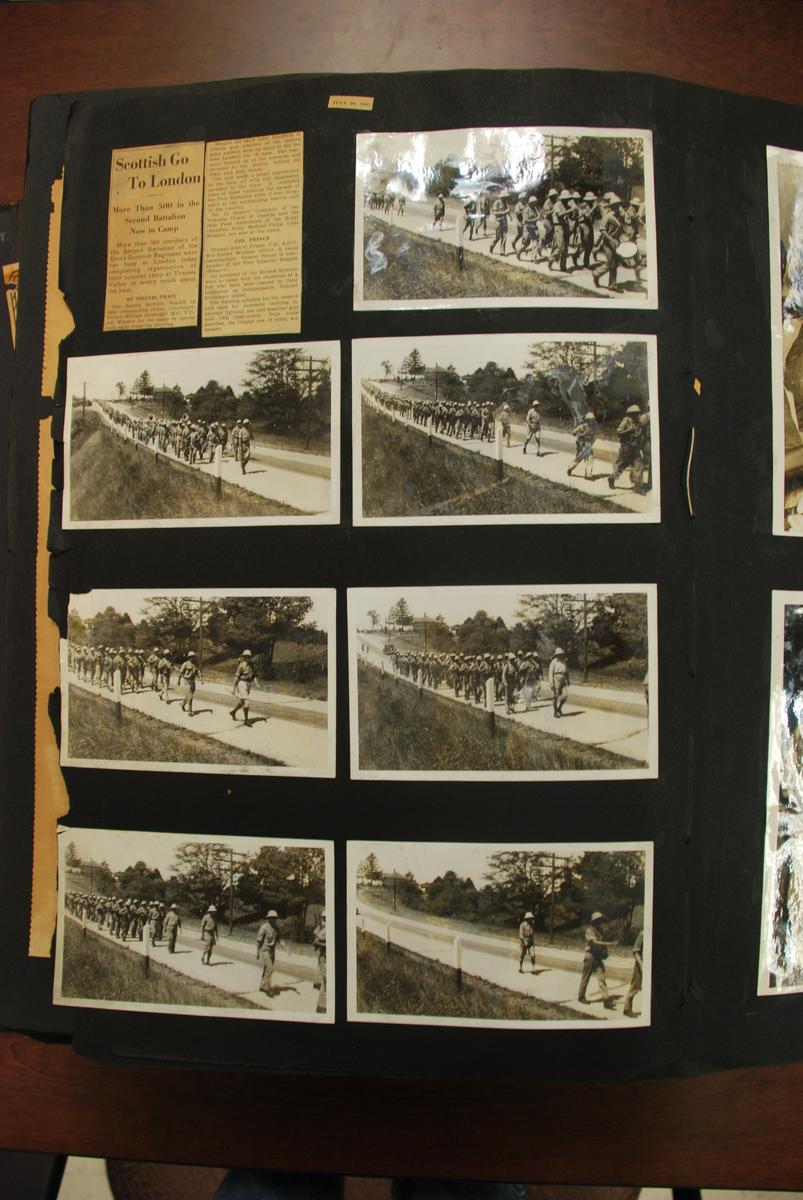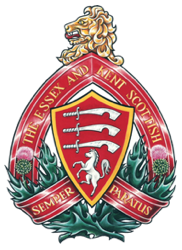The Essex Scottish Regiment in England 1940-1942

Soldiers of the Essex Scottish Regiment march to their base after their arrival in England
On 12 August 1940 began the largest German air offensive of the war, the Blitz over England. The battles for domination of Britain’s skies were intensifying; deadly aerial dogfights and anti-aircraft guns raged at all hours. The bombing campaigns by the German airforce were a source of constant danger for civilians and military personnel. The daytime air was filled with the sounds of air raid sirens and the night sky was lit by searchlights and anti-aircraft fire. Men, women, and children huddled in bunkers and public shelters for days at a time, the terror of being buried alive by German bombs keeping them from sleep. Many British officers feared that a German invasion of the British Isles was imminent. It was in this dreadful climate that The Essex Scottish Regiment (ESR) arrived in England.
The ESR left Canada from the port of Halifax on 23 July 1940. They shared a convoy with the 4th Brigade of the 2nd Canadian Division. Escorted by the battleship H.M.S. REVENGE, they crossed the Atlantic without incident and arrived in Gourock, Scotland on 1 August. Three days later, the battalion was moved to Maida Barracks at Camp Aldershot located southeast of London. Training, marching, and drilling filled most of their days. The only exceptions were Wednesdays, which were designated for sports and recreation. The Scottish witnessed many air battles and bombing raids during their first weeks in England. The most famous of these occurred on 16 August when German planes attacked the battalion’s firing range during a weapons exercise. Lieutenants Mingay and Knox set up their machine guns and returned fire at the German planes, the regiment’s first intentional shots at German forces.
During the early part of the Blitz, the regiment was transferred to East London. It was there that they began preparing a defensive line and performing reconnaissance to repel a potential German invasion on the south coast of England. During this period of high alert, the regiment was inspected by the commander-in-chief of British home forces, Field Marshall Alan Brooke. News agencies including the CBC and British Pathe News came to visit and record the work of the ESR. The regiment was featured in several propaganda films demonstrating military maneuvers. In late December 1940, the regiment was transferred out of London and moved to Brighton for coastal defense. They returned to Aldershot a month later.
During the Blitz, the ESR had been on high alert for four months. Upon their return to Aldershot, many soldiers were given extended leave. Sports and recreation were resumed, and movies were screened for the battalion. In February 1941, the ESR began participating in larger, brigade-sized combat exercises and training missions in many parts of southern England which lasted until mid-March. These training exercises were often held during the torrential rain characteristic of winters in southern England. The men of the ESR often returned to Maida Barracks, Aldershot drenched in water and dirty with mud. They would dry off, clean their equipment, and go to bed only to be resoaked the next day. This series of grueling training operations ended on 20 March when the regiment returned to Aldershot to prepare for that spring’s offensive exercises. On 27 March 1941, the Essex Scottish Regiment was inspected by King George VI. The King complimented on their MacGregor tartan kilts and “Rob Roy” tartan neckties worn by the officers.
From the beginning of April to the end of June 1941, the regiment took part in three major brigade-sized training exercises: JOSEPH, COBRA and WATERLOO. By the end of this three-month training season, the war for the skies of Britain had been won by the allies. In late July, reinforcements from the regiment’s 2nd Battalion in Windsor arrived in England and began basic training and maneuver drills. The battalions were then inspected again by Field Marshall Alan Brooke, who during his stay watched a baseball game between the 1st Battalion’s A Company and HQ Company. In August, the ESR was relieved by the 6th Manchester Regiment and was sent to billet in Camberley, Surrey. They resumed regular training drills except for Operation BUMPER, a corps-sized training exercise that took place in mid-September. During the fall, the ESR conducted battle drills all over the English countryside before arriving in St. Leonard's, south of Dorset in January 1942.
From January to May 1942, the ESR was involved in numerous battalion-sized beach landing exercises. Unbeknownst by the soldiers, preparation for the Dieppe Raid had begun. The ESR was transferred to the Isle of Wight off the south coast of England for intense amphibious battle training. For over two months, the ESR and the rest of the 4th Brigade participated in training Operations BEAVER 1-4 and YUKON 1-2. Their experience on the Isle of Wight would be vital to the Regiment in Dieppe.
The soldiers of the ESR had spent two years living and training in England. They met the King, toured the towns, and became friendly with the locals. They witnessed the beginning and conclusion of the struggle for British airspace. In August 1942, the unit would suffer 90% casualties on the beaches of Dieppe, France during the ill-fated Operation JUBILEE. Of the 553 all ranks that landed on the beach of Dieppe with the Regiment, only 51 would return to England, though 27 were wounded and later two died.
Story by Calvin Barrett, Canada Summer Jobs 2022 participant
with The Essex and Kent Scottish Regiment Association
Sources
- Battalion leadership in the Essex Scottish Regiment and the 4th Canadian Infantry Brigade during the Second World War by John James Maker, 2004
- Duty Nobly Done, The History of The Essex and Kent Scottish Regiment by Sandy Antal and Kevin R. Shackleton, 2006 – Chapter 10
- 1st Battalion, The Essex Scottish Regiment 1939-1945 booklet (1946)
